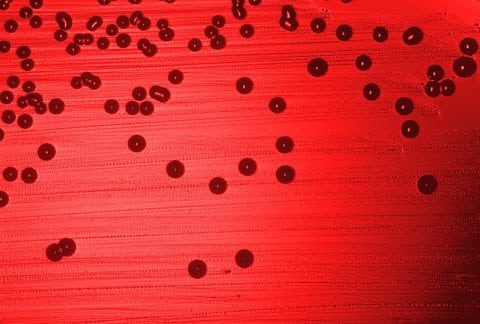
Haemophilus influenzae bacteria cultured on a blood agar plate.
I recently cared for a child with a bloodstream infection caused by a nontypable Haemophilus influenza, one of the more common causes of childhood upper and lower respiratory tract infections such as sinusitis and pneumonia. It isn’t a common cause of disseminated infection, but it isn’t unheard of and it tends to have a good outcome. The child received appropriate medical care and left the hospital smiling in anticipation of seeing her friends at school the next day.
What made this case particularly interesting to me wasn’t what bacteria caused her illness but what bacteria didn’t. I couldn’t help but consider how the course of this child’s life would have almost certainly been changed for the worse, if she even survived, had she suffered from disease caused by a very closely related and much more dangerous bug: Haemophilus influenza type b, also known as Hib. Hib, an adversary of humanity that still strikes fear in the hearts of many a pediatric medical professional, is a bacterial pathogen that I have never seen and probably never will.
Since 1990, at least in the United States and most of the developed world, infants have received an extremely effective vaccine that protects them from Hib. As expected, the incidence of infection with this dreaded bacterium has plummeted dramatically. So very few children in regions where the vaccine is in widespread use will ever experience the meningitis, epiglottitis, or cellulitis that in the past killed thousands of children every year.
And now the bad news…
Unfortunately, a paper published in PLOS Medicine earlier this week detailed a worrisome trend in several states. More parents are seeking out nonmedical exemptions (NMEs) in several states despite all the efforts of the medical community and other proponents of vaccines, the overwhelming success of vaccines such as the one that has prevented immeasurable suffering from Hib infections over the years, and the increasing outbreaks of vaccine preventable infections across the country.
Currently 18 states allow so-called “philosophical-belief” exemptions from childhood vaccination, while all but three (CA, MS, WV) allow exemptions based on religion. According to data compiled since 2009, rates of these non-religious NMEs have increased in 12 of the 18 states. The states with these higher rates of NMEs are Arkansas, Arizona, Idaho, Maine, Minnesota, North Dakota, Ohio, Oklahoma, Oregon, Pennsylvania, Texas, and Utah.
Vaccine exemption “hotspots” are putting more kids at risk
Rates of vaccination against the most serious infections, such as measles and Hib, are still very high, although only 72% of toddlers had received all recommended vaccines in 2015. And there is growing concern that unprotected children are forming clusters is certain areas. The researchers looked at exemption rates in individual counties and located several “hotspots”, defined as having more than 400 kindergarten-aged children with NMEs, some of which were found in major cities with international airports such as Seattle, Phoenix, and Houston. So there are a lot of kids who are not going to benefit from herd immunity. This is scary stuff.
There were a few other interesting and concerning findings that shouldn’t really surprise anyone. In states with more NMEs, there was a corresponding decrease in rates of vaccination against measles, mumps, and rubella. You probably are familiar with measles and mumps, but rubella, which I haven’t covered in a prior post, is just as scary because it likes to cause severe disease in babies still in the womb. It has been eliminated from the Americas but, as you know, everything is only a quick flight away.
Curious which states have the highest MMR vaccination rates? It’s the three states that have banned all nonmedical exemptions of course. That’s Mississippi, California, and West Virginia if you are keeping score. The authors point out the increased vaccination rates in California after their 2016 legislation doing away with NMEs and call for other states to enact similar policies.
Conclusion: Some doom and gloom for your Friday
As we’ve pointed out countless times here on SBM, childhood vaccinations stand out as one of the most successful public health interventions of all time. They have saved millions of lives and prevented untold suffering. They are safe and they are effective.
Despite this, we are seeing a rise in parents seeking to exempt their children from the recommended vaccine schedule and this new paper further reveals that many of these children are clustered and perfectly positioned to serve as epidemiological kindling. The reasons that these parents seek exemptions are many, and have largely been covered in previous posts. My fear is that we are past the point of reversing this trend and that only a series of large and deadly outbreaks will get through. That may not even be enough for some.
Sorry for the pessimistic conclusion.

